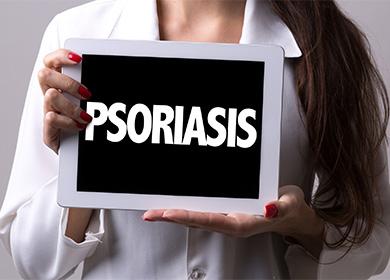The content of the article
This is a chronic dermatological disease that occurs for many years with periodic relapses and remissions. In the ICD-10, he was assigned the number L40.0.
Psoriasis is an autoimmune pathology in which your own immune system attacks and damages skin cells. As a result, intensive formation of new cells occurs, and characteristic rashes appear.
Normally, the epidermis takes about four weeks to fully update. In psoriasis, similar proliferation processes occur in three to four days. With such rapid cell growth, normal layers of the epidermis do not form, and characteristic psoriatic formations form instead. Reddish, scaly rashes that rise above the surface of the skin - this is how psoriasis looks.
Classification
Most formations are localized in a specific part of the body, on the face, but in some cases they can spread over a fairly large area. It is still unclear why such a malfunction of the immune system occurs and how proliferation mechanisms are disrupted.
There are several forms of psoriasis. They are differentiated depending on the location of the rashes and their nature:
- palmar-plantar psoriasis;
- teardrop-shaped psoriasis;
- vulgar (plaque) psoriasis;
- psoriatic erythroderma;
- psoriasis of the folds;
- nail psoriasis;
- scalp psoriasis;
- psoriatic arthritis.
Symptoms
The main symptom of psoriasis is the appearance of characteristic rashes on the skin. Education have some features.
- sharply defined contours;
- reddish color;
- raised above the surface of the skin;
- covered with whitish scales.
Psoriatic spots are often small and punctate, but in some cases can cover large areas of the body. The surface layer of such a rash can be easily cleaned, the lower one is firmly fixed on a thin layer of skin. If you try to remove it, then there is a slight point bleeding. This is the so-called Auspitz phenomenon.
The most common localization sites for such skin elements are:
- cubit;
- knee;
- sacrum;
- scalp;
- gluteal folds;
- the area behind the ears;
- umbilical region.
In severe forms of the disease, rashes are not limited to the above areas of the body. They can spread over vast areas of the trunk and limbs, change the appearance of the patient beyond recognition.
Gradually, psoriatic rashes disappear, without leaving consequences on the skin. The period of remission can be different - from two to three weeks to several years.
Diagnostics
A dermatologist may suspect this disease already on the basis of a patient examination. A test is also carried out with the scraping of surface scales, the presence of the Auspitz phenomenon confirms the diagnosis. Nail changes characteristic of psoriasis can also be an additional diagnostic criterion. In rare cases, a histological analysis of the skin area (biopsy) may be necessary.
Differential diagnosis is carried out with the following diseases:
- fungal infections;
- syphilis;
- multi-colored lichen;
- seborrheic dermatitis.
Causes of Psoriasis
The exact causes of psoriasis are still unknown. But the fact is established that psoriasis is not contagious, is not transmitted by contact. However, there is evidence confirming the hereditary nature of this disease. A person can inherit a predisposition to him from his parents, but this does not mean that he will necessarily fall ill. Predisposing factors are:
- streptococcal infection;
- chronic stress;
- taking immunosuppressive drugs;
- HIV
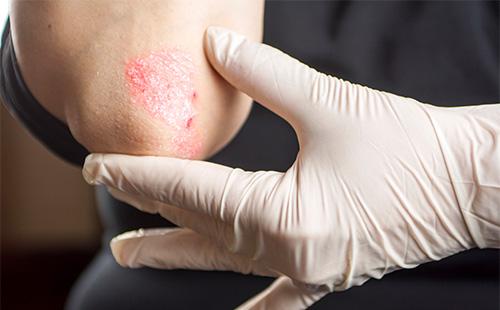
Treatment
There are no effective treatments for psoriasis. However, there are remedies that significantly reduce symptoms, sometimes leading to their disappearance.
Basic care
The treatment of psoriasis primarily involves proper skin care. Ideal are special oily shower gels, ointments and high fat creams. They increase the protective properties of the upper layers of the skin and prevent its drying out. Cosmetic preparations containing urea and salicylic, lactic acid also have a positive effect in psoriasis. Additional therapeutic measures are also taken depending on the severity of the symptoms.
Light form
With a mild course of the disease, in most cases they rely on local treatment. Use substances that slow the excessive growth of skin cells and have an anti-inflammatory effect. Special creams, gels, lotions, shampoos for the treatment of psoriasis are available.
The most commonly used substances are:
- derivatives of vitamin D3;
- cortisone;
- dithranol, cinnoline;
- derivatives of vitamin A.
The most common drugs with dithranol. This substance inhibits excessive cell growth and inflammation. Side effects of dithranol therapy include irritation and discoloration of the skin, bedding, and clothing. Pharmacologists have developed the so-called "minute therapy": a drug with a high concentration of ditranol is kept in the affected areas for up to half an hour. According to reviews, the effectiveness of the procedure is not lower than with prolonged use of the drug.
Drugs withvitamin D also have anti-inflammatory effects and are part of standard therapy. Can be used alone or combined with selective phototherapy.
Vitamin D is often combined with cortisone ointments. This scheme is well suited at the initial stage of treatment, but it can not be used for a long time. With constant use, cortisone makes the skin in the treated areas thinner and more susceptible to infection.
Treatment with vitamin A derivatives (retinoids) gives a good effect in combination with an external treatment, such as ultraviolet light.This group of drugs normalizes cell growth, accelerates desquamation (flaking flakes) and has an anti-inflammatory effect.
If psoriasis occurs on the face, between the fingers, in the genital area or on the buttocks, then in some cases, calcineurin inhibitors have a good effect. On the pharmaceutical market they are presented as Tacrolimus and Pimecrolimus preparations.
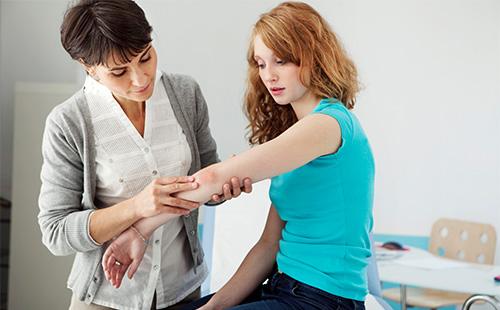
Moderate and severe
With this variant of the disease, drugs that affect the functioning of the immune system are additionally used. For example, can be assigned:
- Cyclosporin;
- fumaric acid esters;
- "Methotrexate."
This approach is due to the fact that the development of psoriasis is caused by a violation of the immune response in the body. Also, for the treatment of this disease, drugs are used, the active ingredient of which is etanercept. It is available in injectable form.
Other possible medications for treating moderate to severe forms of psoriasis are:
- Adalimumab
- Infliximab
- Iksekizumab;
- Ustekinumab.
"Iksekizumab" has an effect on the links of the immune system. It inhibits certain T cells and inflammatory mediators. The cost of this medicine is quite high, and the long-term effects are still unknown. Use these drugs after consultation with your doctor.
Phototherapy
In this case, the therapeutic effect on the skin is provided by light rays. In a tanning bed, the patient is exposed to natural sunlight (heliotherapy) or special rays. The most effective in the treatment of psoriasis were lamps emitting rays with a wavelength of 311 nm.
There are also combined methods of treatment with light. Their principle is to enhance the action of rays on the skin with the help of other components (balneotherapy, “Psoralen”).
Laser therapy
In fact, laser treatment is a form of phototherapy. However, during laser therapy, the beam is aimed strictly at the damaged areas of the skin. Also, more powerful radiation energy is used, while the surface layers of the skin are processed and the underlying tissues are not damaged. Laser therapy is particularly suitable for the treatment of small foci of psoriasis, such as psoriasis on the arms or legs.
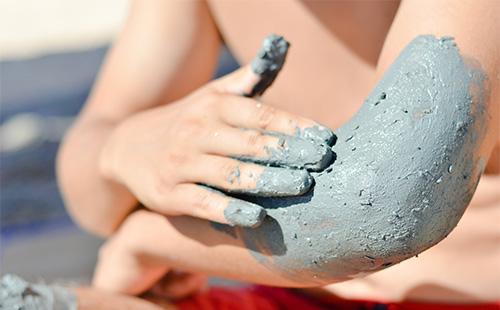
Climatotherapy
Some experts recommend that patients with psoriasis on the body change their climate zone or move to another region. A typical example of climate therapy is staying at the Dead Sea, where the sun and salt water have a positive effect on the skin.
Elimination of provoking factors
If a connection is established between the relapse of psoriasis and streptococcus, then it is necessary to eliminate the foci of infection. In the case of frequent tonsillitis or exacerbations of chronic tonsillitis, surgical removal of the tonsils is possible. Often after this, the course of psoriasis improves in the long term, in some cases, its exacerbations do not occur at all.
Salt baths
Salt water baths can also be used as part of psoriasis therapy. Water with a high salt content (20-30%) is produced from underground wells. It contains a high percentage of sodium chloride and other minerals.Studies have shown that concentrated saline reduces inflammation on the skin and thus alleviates the symptoms of psoriasis.
Folk remedies
There are many different folk recipes that can relieve exacerbation of psoriasis. They can be used independently at home. These include some edible oils. For example, almond, primrose, grape seed extract. There are reviews of the good effectiveness of clay wraps or rubbing skin with shea butter.
Alternative methods
Alternative methods can also be used to treat psoriasis: traditional Chinese medicine, homeopathy, silymarin preparations. However, their effectiveness is largely unproven.
Psychotherapy
Medical studies have shown that people with psoriasis experience greater psychological discomfort than patients with serious illnesses such as diabetes mellitus or bronchial asthma. People with skin rashes often feel disfigured, their self-esteem and a sense of inner confidence are violated.
Young people are particularly affected, they shun their peers and acquaintances, despite the fact that the disease is not contagious. In this case, the localization of the process is of great importance, if the face is affected, the genital area or rashes are on the head, then this can cause serious psychological problems.
Psychologists recommend the use of such treatment methods as psychoanalysis, behavioral therapy or relaxation methods. An exchange of experience in target self-help groups with other similar patients is also effective. In folk medicine, methods of psychotherapy and suggestions are also used - for example, conspiracies from psoriasis.
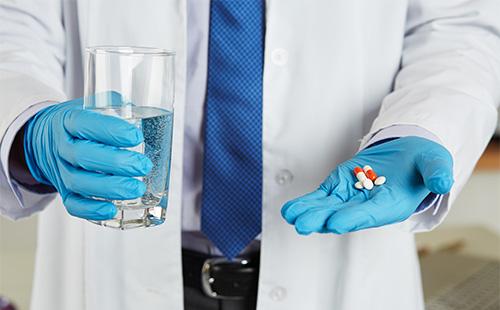
Healthy lifestyle
Those who eat right, don’t smoke, drink alcohol moderately, monitor their weight, have a strong immune system and are less prone to relapse of psoriasis.
Scientific studies show that psoriatic rashes are more pronounced in smokers than in non-smokers. In people who smoke 15 cigarettes a day or more, the risk of developing the disease is tripled. It is also known that in men who consume a lot of alcohol, psoriasis is much more common. Therefore, rejection of bad habits serves as a good prevention of relapse of psoriasis.
Nutrition
There are many dietary recommendations for psoriasis. However, the fundamental principles of such nutrition are as follows:
- reduce consumption - products containing linoleic and gamma-linoleic acids (pork, sausages and smoked meats, veal);
- from meat prefer - chicken, turkey, rabbit;
- increase consumption - products with vitamin D, zinc;
- daily include in the menu - fish with a high fat content (salmon, trout, mackerel).
The treatment of psoriasis is a whole complex of measures, both local and systemic. Therapy of this pathology is carried out by dermatologists, immunologists, general practitioners. Only an experienced specialist will be able to correctly draw up a treatment regimen taking into account the severity and stage of the process. Use folk methods must be extremely careful. Before treating psoriasis at home, you should definitely consult a doctor.
